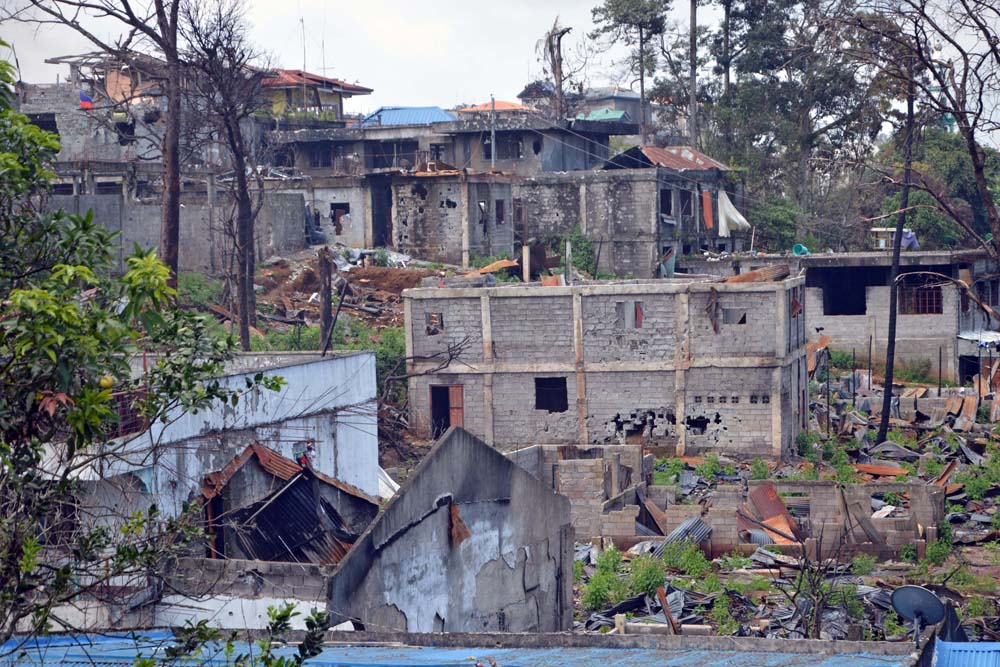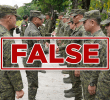
(Divina M. Suson/davaotoday.com)
MARAWI CITY, Philippines – One hundred days after the fighting between Islamic State of Iraq and Syria-inspired militants and government forces, portions of Marawi City are already beyond recognition.
Under the rubbles of gray and burned houses on a corner of a village here where journalists were permitted to enter on Wednesday, Khadaffy Daromimbang was sure that it was the compound where his sister once lived.
Daromimbang is a Maranao resident who works with the provincial government as a staff who got to see for the first time how the war has destroyed their city.
He may be considered lucky to be the first Maranao to get inside the city where they fled three months ago. But he felt
only grief seeing the extent of destruction.
“Naiyak ako kasi nakita ko iyong bahay sira-sira. Alam mo yong compound na yon, Rakila Compound, doon kami palagi nagsama-sama tuwing Eid al-Adha, pamilya kami tuwing Hariraya. Pero ngayon wala na, kaya naiyak ako,” he said.
(I saw her house totally destroyed. I know that compound, the Rakila Compound, that was where we gather during Eid Al-Adha. We are always a family during Hariraya. But now there is nothing left.)
If the crisis did not happen, they are supposed to gather in that same compound for the Eid Al-Adha today, Sept. 1.
He has been requesting the military to see by himself how his place looks like after the three month war where troops continue to launch aerial bombardment to flush out the extremists.
Daromimbang hopes to join the media again in an embed with the troops to the Grand Mosque.
He said he wants to be the first to pray in the Mosque where he and his family were once united before the war broke out
The Joint Task Force Marawi finally allowed journalists to cross the Baloi Bridge (known as Mapandi Bridge) that connects Barangay Raya Saduc to Barangay Bubong Madaya, the former stronghold of the ISIS-inspired Maute group.
It was a gesture of the military to prove that the government is gaining ground against its enemy. The military said they have cornered the militants in a “500-square meter area.”
Amid heavy gunfights and aerial bombardment some 100 meters away, the military opened up the bridge covered with laminated sacks so that enemies are prevented from seeing the movement of troops.
The Mapandi Bridge, that connects the eastern and the western parts of the city, was recaptured month ago, but the area was guarded from civilians and the media.
Brigadier General Melquiades Ordiales, commander of the 1st Marine Brigade, said that Mapandi Bridge is very significant in their operations because it is the main route for the military in bringing their supplies up to the main battle area.
He said the soldiers have difficulty in capturing the city because of the high-rise buildings and solid structures. However, Ordiales said the more the soldiers were wounded, the braver they got.
It took them about two months to reach the place and upon reaching the area on the left side, it took them one week to cross the street incurring many casualties. Philippine soldiers are more used to jungle warfare and not in urban fighting.
“We have five killed-in-action and about 30 wounded troops. We have hard time getting this small space because the enemies were positioned at the entrance,” Ordiales said.
He said crossing the first street was really difficult for the Marines.
“But we were able to make it,” he said.
Ordiales claimed they are “on the last and final push.” He said the gunfight heard from the next block is a normal situation.
Brigadier General Joselito D. Bautista said the 100 days of fighting urban terrorism taught them a lesson — to give full support to the advance troops and concentrate all the fire power to clear the way for the advance group.
After seizing the Grand Mosque, the troops now eye the Bato Ali Mosque, which, they say, is where the militants took refuge after they escape from the Grand Mosque.
They believe the enemies are holed up in Bato Ali Mosque with the remaining hostages that includes women, children, elderly and the parish priest Fr. Chito Suganob. (davaotoday.com)










